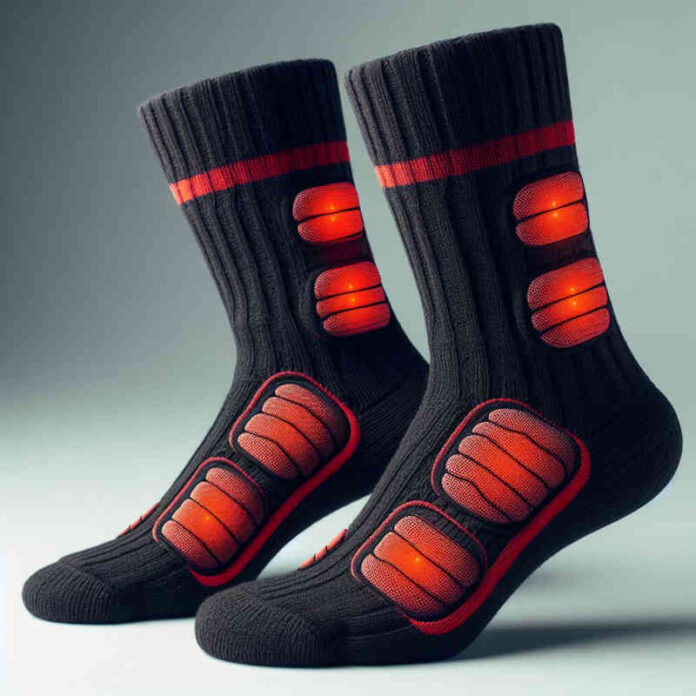
For those who battle chronically cold feet or spend time in frigid environments, heated socks can be a game-changer. These innovative socks integrate heating elements to generate warmth, keeping your toes toasty and comfortable.
There are already different types of heated clothing on the market that we will be able to talk about in the future.
Now before you dive into the world of heated socks, here’s a comprehensive guide to inform your purchase decision.
Understanding How Heated Socks Work:
They typically consist of:
- Breathable Fabric: The outer layer is often made of wool, merino wool, nylon, or a blend. These materials offer breathability and moisture-wicking properties to prevent sweat build-up.
- Heating Elements: Thin wires woven into the fabric generate heat when powered by a battery pack. They’re strategically placed in the toe box, sometimes extending towards the arch or sole.
- Battery Packs: Rechargeable lithium-ion batteries are most common. They come in various sizes and capacities, impacting heat duration and sock weight.
- Control System: A control panel, usually embedded in the cuff or a separate remote, allows you to adjust heat settings (low, medium, high) and turn the socks on/off.
Benefits of Heated Socks:
- Combating Cold Feet: They provide targeted warmth to chronically cold feet, improving comfort and blood circulation, especially beneficial for people with Raynaud’s syndrome.
- Enhanced Performance: For athletes or outdoor enthusiasts, they can help maintain muscle warmth, leading to improved performance and faster recovery.
- Comfort in Frigid Environments: Whether working outdoors, skiing, or enjoying winter sports, they keep your feet warm in cold weather.
- Improved Circulation: The gentle warmth can stimulate blood flow, aiding those with circulatory issues or diabetes (consult your doctor before use).
Factors to Consider Before Buying Heated Socks:
Choosing the right heated socks requires careful consideration of several factors:
- Heat Settings and Duration:
- Settings: Look for socks with multiple heat levels for adjusting warmth based on activity and weather conditions.
- Duration: Battery capacity determines how long the socks stay warm on a single charge. Higher capacity batteries provide longer warmth but add weight.
- Sock Material and Thickness:
- Material: Choose a material that balances warmth with breathability. Wool or merino wool offer excellent warmth, while nylon blends provide better moisture-wicking properties.
- Thickness: Consider the intended use. Thicker socks are warmer but less suitable for activities requiring dexterity.
- Battery Size and Placement:
- Size: A larger battery provides longer warmth but adds bulk. Evaluate the trade-off between warmth and comfort.
- Placement: External battery packs in pockets can be cumbersome. Socks with built-in batteries offer a cleaner look but might limit weight distribution.
- Durability and Care:
- Construction: Look for well-sewn seams and high-quality materials that can withstand wear and tear.
- Washing Instructions: Ensure the socks are machine washable (follow specific instructions) to maintain hygiene.
- Warranty: Consider a warranty that covers any potential heating element malfunctions.
Safety Considerations with Heated Socks:
While generally safe, they come with some safety considerations:
- Overheating: Improper use or prolonged exposure to high heat settings can cause burns. Monitor your feet regularly and adjust settings accordingly.
- Diabetic Concerns: Reduced sensation in the feet can make it difficult to detect burns. Diabetics should consult their doctor before using heated socks.
- Battery Safety: Follow proper charging protocols and avoid using damaged batteries to prevent potential fire hazards.
Who Can Benefit Most from Heated Socks?
Heated socks cater to a diverse range of users:
- People with Chronically Cold Feet: Those who experience Raynaud’s syndrome or simply have perpetually cold feet can find immense comfort in heated socks.
- Outdoor Enthusiasts: Hikers, skiers, snowboarders, and anyone spending extended time in cold weather benefit from the targeted warmth to maintain comfort and performance.
- Winter Sports Participants: From ice fishing to snowmobiling, heated socks keep toes warm during winter activities.
- People with Jobs in Cold Environments: Construction workers, warehouse personnel, or anyone working in cold conditions can experience improved comfort and productivity.
Disadvantages of Heated Socks:
- Cost: Heated socks can be more expensive than regular socks, especially high-quality models with advanced features.
- Bulk and Weight: The battery pack and heating elements add weight and bulk to the socks, potentially impacting comfort and shoe fit.
- Limited Heat Duration: Battery life dictates how long the socks stay warm on a single charge. Carrying spare batteries adds extra weight and requires planning for recharging.
- Uneven Heat Distribution: Heating elements might not distribute heat uniformly across the entire foot, leaving some areas cooler.
- Potential for Discomfort: Seams around the heating elements or bulky battery packs can cause irritation for some users.
- Drying Time: Heated socks might take longer to dry after use due to the electronic components, requiring extra care to prevent moisture buildup and potential odor.
- Limited Washing Options: Some heated socks require handwashing or specific washing instructions to maintain functionality.
Additional Considerations:
Impact on Sweating: While some socks are breathable, using heated socks in warmer environments can lead to sweating, negating the comfort benefits.
Not Suitable for Everyone: People with certain medical conditions, particularly those affecting circulation or sensation in the feet, should consult a doctor before using heated socks.
A brief final conclusion:
Heated socks represent a technological advancement in keeping your feet warm and comfortable in cold environments.
By understanding their functionality, benefits, considerations and both the advantages and disadvantages, you can make an informed purchase decision.
Whether you battle chronic coldness or simply want extra warmth for winter adventures, heated socks can be a valuable addition to your winter gear.



